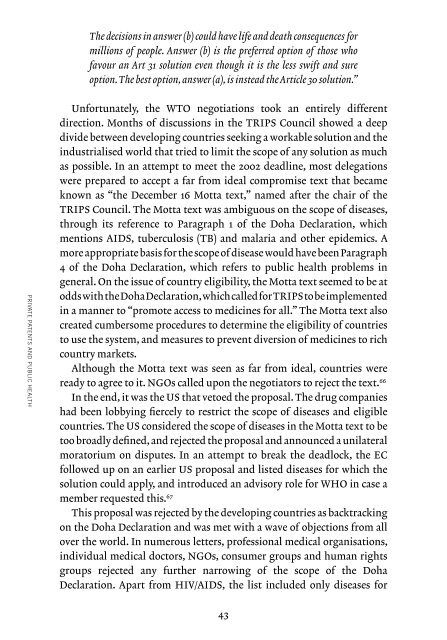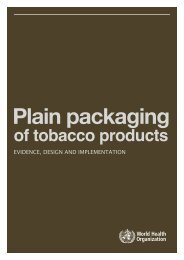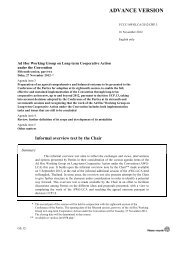PRIVATE PATENTS AND PUBLIC HEALTH
private-patents-and-public-health
private-patents-and-public-health
Create successful ePaper yourself
Turn your PDF publications into a flip-book with our unique Google optimized e-Paper software.
The decisions in answer (b) could have life and death consequences for<br />
millions of people. Answer (b) is the preferred option of those who<br />
favour an Art 31 solution even though it is the less swift and sure<br />
option. The best option, answer (a), is instead the Article 30 solution.”<br />
<strong>PRIVATE</strong> <strong>PATENTS</strong> <strong>AND</strong> <strong>PUBLIC</strong> <strong>HEALTH</strong><br />
Unfortunately, the WTO negotiations took an entirely different<br />
direction. Months of discussions in the TRIPS Council showed a deep<br />
divide between developing countries seeking a workable solution and the<br />
industrialised world that tried to limit the scope of any solution as much<br />
as possible. In an attempt to meet the 2002 deadline, most delegations<br />
were prepared to accept a far from ideal compromise text that became<br />
known as “the December 16 Motta text,” named after the chair of the<br />
TRIPS Council. The Motta text was ambiguous on the scope of diseases,<br />
through its reference to Paragraph 1 of the Doha Declaration, which<br />
mentions AIDS, tuberculosis (TB) and malaria and other epidemics. A<br />
more appropriate basis for the scope of disease would have been Paragraph<br />
4 of the Doha Declaration, which refers to public health problems in<br />
general. On the issue of country eligibility, the Motta text seemed to be at<br />
odds with the Doha Declaration, which called for TRIPS to be implemented<br />
in a manner to “promote access to medicines for all.” The Motta text also<br />
created cumbersome procedures to determine the eligibility of countries<br />
to use the system, and measures to prevent diversion of medicines to rich<br />
country markets.<br />
Although the Motta text was seen as far from ideal, countries were<br />
ready to agree to it. NGOs called upon the negotiators to reject the text. 66<br />
In the end, it was the US that vetoed the proposal. The drug companies<br />
had been lobbying fiercely to restrict the scope of diseases and eligible<br />
countries. The US considered the scope of diseases in the Motta text to be<br />
too broadly defined, and rejected the proposal and announced a unilateral<br />
moratorium on disputes. In an attempt to break the deadlock, the EC<br />
followed up on an earlier US proposal and listed diseases for which the<br />
solution could apply, and introduced an advisory role for WHO in case a<br />
member requested this. 67<br />
This proposal was rejected by the developing countries as backtracking<br />
on the Doha Declaration and was met with a wave of objections from all<br />
over the world. In numerous letters, professional medical organisations,<br />
individual medical doctors, NGOs, consumer groups and human rights<br />
groups rejected any further narrowing of the scope of the Doha<br />
Declaration. Apart from HIV/AIDS, the list included only diseases for<br />
43






